
Kitagawa Utamaro was a Japanese artist. He is one of the most highly regarded designers of ukiyo-e woodblock prints and paintings, and is best known for his bijin ōkubi-e "large-headed pictures of beautiful women" of the 1790s. He also produced nature studies, particularly illustrated books of insects.
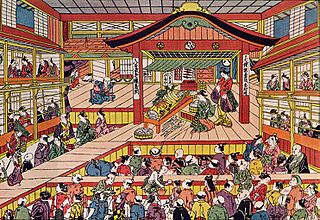
Ukiyo-e is a genre of Japanese art that flourished from the 17th through 19th centuries. Its artists produced woodblock prints and paintings of such subjects as female beauties; kabuki actors and sumo wrestlers; scenes from history and folk tales; travel scenes and landscapes; flora and fauna; and erotica. The term ukiyo-e translates as 'picture[s] of the floating world'.
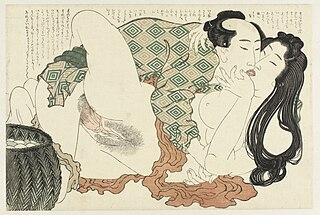
Shunga (春画) is a type of Japanese erotic art typically executed as a kind of ukiyo-e, often in woodblock print format. While rare, there are also extant erotic painted handscrolls which predate ukiyo-e. Translated literally, the Japanese word shunga means picture of spring; "spring" is a common euphemism for sex.

Hasui Kawase was a Japanese artist who was one of 20th century Japan's most important and prolific printmakers. He was a prominent designer of the shin-hanga movement, whose artists depicted traditional subjects with a style influenced by Western art. Like many earlier ukiyo-e prints, Hasui's works were commonly landscapes, but displayed atmospheric effects and natural lighting.

Shinsui Itō was the pseudonym of a Nihonga painter and ukiyo-e woodblock print artist in Taishō- and Shōwa-period Japan. He was one of the great names of the shin-hanga art movement, which revitalized the traditional art after it began to decline with the advent of photography in the early 20th century. His real name was Itō Hajime.
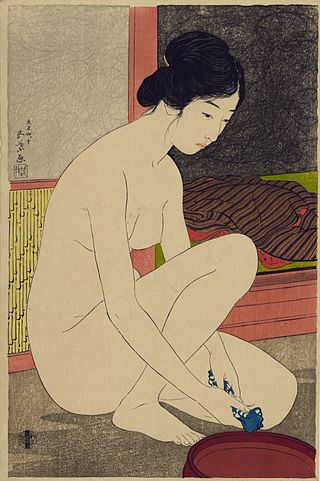
Shin-hanga was an art movement in early 20th-century Japan, during the Taishō and Shōwa periods, that revitalized the traditional ukiyo-e art rooted in the Edo and Meiji periods. It maintained the traditional ukiyo-e collaborative system where the artist, carver, printer, and publisher engaged in division of labor, as opposed to the parallel sōsaku-hanga movement.

Torii Kiyonaga was a Japanese ukiyo-e artist of the Torii school. Originally Sekiguchi Shinsuke, the son of an Edo bookseller, from Motozaimokuchō Itchōme in Edo, he took on Torii Kiyonaga as an art name. Although not biologically related to the Torii family, he became head of the group after the death of his adoptive father and teacher Torii Kiyomitsu.

Isoda Koryūsai was a Japanese ukiyo-e print designer and painter active from 1769 to 1790.

Hiroki Morinoue is an American artist of Japanese descent who has helped to pioneer in the United States the fusion of western Impressionism with modern Japanese design.

Charles William Bartlett was an English painter and printmaker who settled in Hawaii.
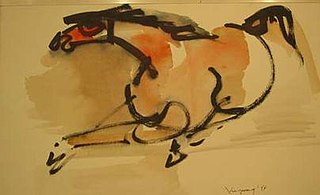
John Chin Young 容澤泉 (1909–1997) was a painter who was born in Honolulu, Hawaii on March 26, 1909. He was the son of Chinese immigrants and began drawing at the age of eight, stimulated by Chinese calligraphy, which he learned in Chinese language school. Young had his first and only art lessons while a student at President William McKinley High School in Honolulu. Thereafter, his art was entirely self-taught. Young is best known for his Zen-like depictions of horses, paintings of children, and abstractions. Over the years, he acquired an important collection of ancient Asian art, which he donated to the Honolulu Museum of Art and the University of Hawaii at Manoa as the John Young Museum. John Chin Young died in 1997 at the age of 88. His daughter Debbie Young is also a painter residing in Hawaii.

John Melville Kelly (1879–1962) was an American painter and printmaker.

John Buck is an American sculptor and printmaker who was born in Ames, Iowa.
Tetsuo Ochikubo (1923–1975), also known as Bob Ochikubo, was a Japanese-American painter, sculpture, and printmaker who was born in Waipahu, Hawaii, Honolulu county, Hawaii. During the Second World War, he served with the 100th Battalion of the 442nd Regimental Combat Team. After being discharged from the Army, he studied painting and design at the School of the Art Institute of Chicago and at the Art Students League of New York. In 1953, he spent a year in Japan, studying traditional brush painting and connecting with his ancestry. He worked at Tamarind Institute in the 1960s and is best known for his entirely abstract paintings and lithographs. Along with Satoru Abe, Bumpei Akaji, Edmund Chung, Jerry T. Okimoto, James Park, and Tadashi Sato, Ochikubo was a member of the Metcalf Chateau, a group of seven Asian-American artists with ties to Honolulu. Ochikubo died in Kawaihae, Hawaii in 1975.
Tadashi Nakayama was a Japanese woodblock print artist, working in a style that combines influences from traditional Japanese ukiyo-e prints and Western painting.

Ishikawa Toyonobu was a Japanese ukiyo-e print artist. He is sometimes said to have been the same person as Nishimura Shigenobu, a contemporary ukiyo-e artist and student of Nishimura Shigenaga about whom very little is known.
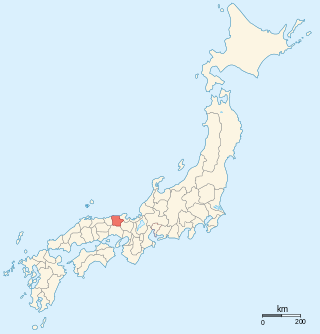
Utagawa Toyoharu was a Japanese artist in the ukiyo-e genre, known as the founder of the Utagawa school and for his uki-e pictures that incorporated Western-style geometrical perspective to create a sense of depth.
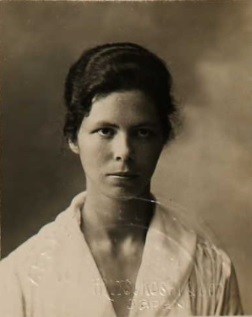
Lilian May Miller was an American painter, woodblock printmaker and poet born in Tokyo, Japan. In the world of art she marked her place with imagery, while she attended presentations in traditional kimonos, and signed her paintings with a monogram.

Chōbunsai Eishi was a Japanese ukiyo-e artist. His last name was Hosoda (細田). His first name was Tokitomi (時富). His common name was Taminosuke (民之丞) and later Yasaburo (弥三郎). Pupil of Kano Eisen'in Michinobu. Born as the first son of direct vassal of the Shogunate, a well-off samurai family that was part of the Fujiwara clan. Eishi was a vassal of the Shogunate with a generous stipend of 500 'koku' of rice. Eishi left his employ with the Shōgun Ieharu to pursue art. His early works were prints, mostly Bijin-ga portraits of tall, thin, graceful beauties in the original style established by himself akin to Kiyonaga and Utamaro. He established his own school and was a rival to Utamaro. He was a prolific painter, and from 1801 gave up print designing to devote himself to painting.
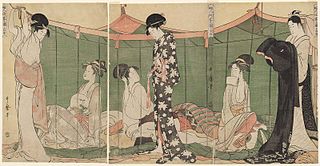
Fujin Tomari-kyaku no Zu Sanmai-tsuzuki is a triptych print by the Japanese ukiyo-e artist Kitagawa Utamaro. It depicts a group of women within a mosquito net preparing for an overnight visit.






















